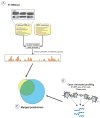Perspectives on Gene Regulatory Network Evolution
- PMID: 28528721
- PMCID: PMC5608025
- DOI: 10.1016/j.tig.2017.04.005
Perspectives on Gene Regulatory Network Evolution
Abstract
Animal development proceeds through the activity of genes and their cis-regulatory modules (CRMs) working together in sets of gene regulatory networks (GRNs). The emergence of species-specific traits and novel structures results from evolutionary changes in GRNs. Recent work in a wide variety of animal models, and particularly in insects, has started to reveal the modes and mechanisms of GRN evolution. I discuss here various aspects of GRN evolution and argue that developmental system drift (DSD), in which conserved phenotype is nevertheless a result of changed genetic interactions, should regularly be viewed from the perspective of GRN evolution. Advances in methods to discover related CRMs in diverse insect species, a critical requirement for detailed GRN characterization, are also described.
Keywords: DSD; GRN; cis-regulatory module; developmental system drift; enhancer evolution; evodevo.
Copyright © 2017 Elsevier Ltd. All rights reserved.
Figures




References
-
- King MC, Wilson AC. Evolution at two levels in humans and chimpanzees. Science. 1975;188:107–116. - PubMed
-
- Carroll SB, et al. From DNA to Diversity. Molecular Genetics and the Evolution of Animal Design. Blackwell Publishing; 2005.
-
- Davidson EH. The Regulatory Genome: Gene Regulatory Networks in Development and Evolution. Academic Press; 2006.
Publication types
MeSH terms
Grants and funding
LinkOut - more resources
Full Text Sources
Other Literature Sources
Miscellaneous

